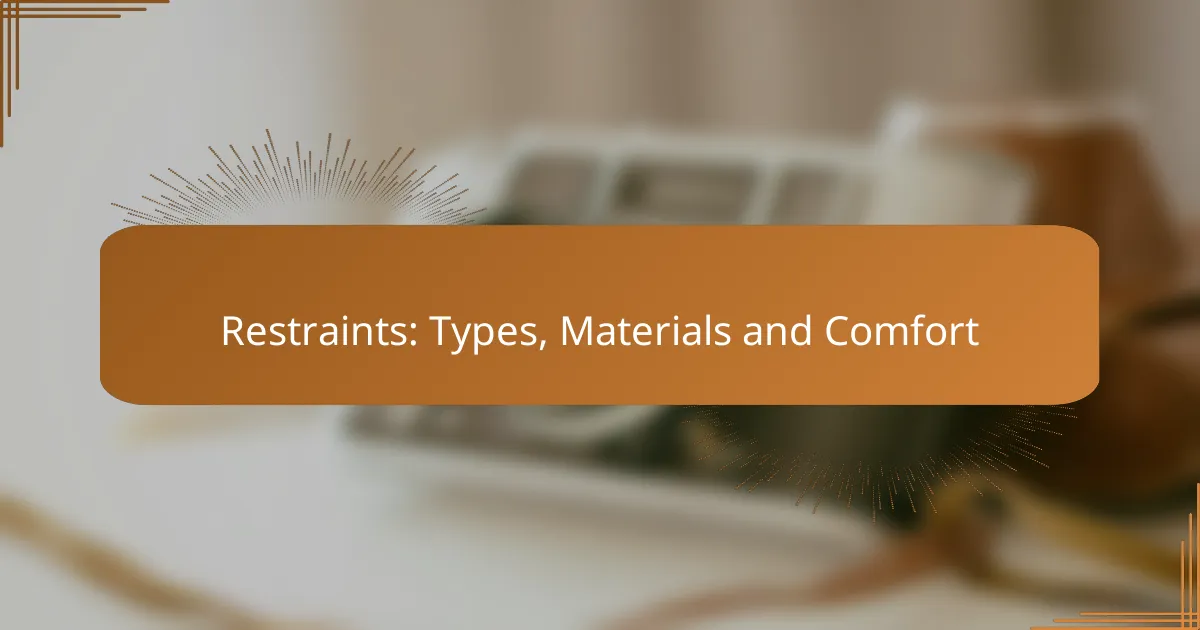Restraints are utilized across various fields such as healthcare and law enforcement, each designed to meet specific needs and situations. The choice of materials plays a crucial role in ensuring comfort, with soft and breathable options helping to minimize irritation. Best practices emphasize the importance of safety and comfort, highlighting the need for proper fitting and regular monitoring to effectively manage their use.

What are the types of restraints available?
There are several types of restraints used in various settings, including healthcare, law enforcement, and behavioral management. Each type serves a specific purpose and is designed to address different situations and needs.
Physical restraints
Physical restraints involve the use of devices or methods to restrict a person’s movement. Common examples include wrist straps, belts, or other equipment that limits mobility. These are often used in medical settings to prevent patients from harming themselves or others.
When considering physical restraints, it is crucial to assess the individual’s needs and the potential risks involved. Always prioritize the least restrictive option and ensure that the use of restraints complies with relevant regulations and ethical guidelines.
Chemical restraints
Chemical restraints refer to the use of medications to manage a person’s behavior or movement. These can include sedatives or antipsychotic drugs prescribed to control agitation or aggression. The goal is to reduce distress while ensuring safety.
It’s important to monitor the effects of chemical restraints closely, as they can have side effects and may not be suitable for everyone. Always consult with a healthcare professional to determine the appropriate medication and dosage.
Mechanical restraints
Mechanical restraints are devices specifically designed to limit movement, such as straitjackets or specialized chairs. These are often used in situations where a person poses a significant risk to themselves or others and requires immediate intervention.
When implementing mechanical restraints, ensure that they are used in accordance with established protocols and that the individual’s comfort and dignity are considered. Regular checks should be performed to monitor the person’s condition and well-being.
Environmental restraints
Environmental restraints involve modifying a person’s surroundings to limit their movement or access to certain areas. This can include locked doors, secured units, or controlled access to specific environments. These measures are often used in facilities like nursing homes or psychiatric hospitals.
While environmental restraints can enhance safety, they should be used judiciously. It’s essential to balance safety with the individual’s right to freedom and autonomy, ensuring that such measures are necessary and appropriate.
Behavioral restraints
Behavioral restraints focus on managing a person’s behavior through non-physical means, such as verbal de-escalation techniques or behavioral contracts. These strategies aim to prevent situations that may lead to the need for more restrictive measures.
Training staff in effective communication and conflict resolution skills is vital for the successful implementation of behavioral restraints. Encourage a supportive environment that promotes positive behavior and minimizes the need for physical or chemical interventions.

How do materials affect restraint comfort?
The materials used in restraints significantly influence comfort levels. Soft, breathable, and durable materials can enhance the user experience by reducing irritation and discomfort during use.
Soft fabrics for comfort
Soft fabrics, such as cotton or fleece, provide a gentle touch against the skin, minimizing chafing and irritation. These materials are often preferred for long-term wear, as they can help prevent discomfort during extended use.
When selecting soft fabrics, consider options with a plush texture that offer cushioning. Look for restraints lined with these materials to ensure maximum comfort, especially for sensitive skin.
Breathable materials for temperature control
Breathable materials, like mesh or moisture-wicking fabrics, are essential for maintaining a comfortable temperature. They allow air circulation, which helps prevent overheating and excessive sweating during use.
Choosing restraints made from breathable materials is particularly important in warmer climates or for activities that involve physical exertion. Look for features such as ventilation holes or moisture management technologies to enhance comfort.
Durable materials for longevity
Durable materials, such as nylon or reinforced polyester, ensure that restraints withstand wear and tear over time. These materials are less likely to fray or break, making them a practical choice for frequent use.
When selecting durable restraints, consider the weight and strength of the material. High-quality options may have additional features like reinforced stitching or weather-resistant coatings, which can further extend their lifespan.

What are the best practices for using restraints?
Best practices for using restraints involve ensuring safety and comfort for the individual while minimizing distress. Proper fitting, regular monitoring, and understanding patient needs are essential components in effectively managing restraints.
Proper fitting techniques
Proper fitting techniques are crucial to ensure that restraints are effective without causing harm or discomfort. Restraints should be snug but not overly tight, allowing for some movement while preventing escape. Regularly check the fit to adjust for changes in the patient’s condition or body size.
Use standardized guidelines to determine the appropriate type and size of restraint for each individual. For example, wrist restraints should allow for a two-finger gap between the restraint and the skin to prevent circulation issues.
Regular monitoring of comfort
Regular monitoring of comfort is essential to prevent complications associated with prolonged restraint use. Check the individual frequently to assess their comfort level and to ensure that the restraints are not causing pain or injury. This includes observing for signs of distress, skin irritation, or restricted circulation.
Establish a schedule for monitoring, such as every 15 to 30 minutes, depending on the situation. Document any observations and adjustments made to the restraints to maintain a clear record of care.
Understanding patient needs
Understanding patient needs is vital for the ethical use of restraints. Engage with the individual to comprehend their preferences and concerns, which can help in selecting the least restrictive option. This approach fosters trust and can reduce anxiety related to restraint use.
Consider factors such as cognitive abilities, emotional state, and past experiences with restraints. Tailoring the approach to the individual can improve compliance and overall well-being, making it easier to manage their care effectively.

What are the safety considerations for restraints?
Safety considerations for restraints focus on minimizing risks to individuals while ensuring their effective use. Key factors include understanding legal regulations, assessing the risk of injury, and obtaining informed consent from those involved.
Legal regulations and guidelines
Legal regulations surrounding restraints vary by country and can dictate when and how they may be used. In many jurisdictions, guidelines emphasize that restraints should only be applied when absolutely necessary to prevent harm to the individual or others.
It is crucial for organizations to stay updated on local laws and institutional policies regarding restraints. Non-compliance can lead to legal repercussions and undermine the safety of both staff and individuals.
Risk of injury assessments
Conducting risk of injury assessments is essential before implementing restraints. These assessments should evaluate the physical and psychological risks associated with the specific restraint method being considered.
Factors to consider include the individual’s health status, history of trauma, and potential for agitation. Regular reviews of restraint practices can help identify patterns and reduce the likelihood of injury over time.
Informed consent processes
Informed consent is a critical component of using restraints, ensuring that individuals understand the reasons and implications of their use. This process should involve clear communication about the necessity and potential risks of restraints.
Obtaining consent may require discussions with the individual, their family, or legal representatives, depending on the context. Documentation of the consent process is important for accountability and transparency.

How do restraints vary across different healthcare settings?
Restraints in healthcare settings differ significantly based on the environment and the specific needs of patients. In acute care, restraints may focus on safety during critical interventions, while in long-term care, they often prioritize patient comfort and dignity.
Types of restraints
Restraints can be categorized into physical, chemical, and environmental types. Physical restraints include devices like belts or straps that limit movement, while chemical restraints involve medications that sedate a patient. Environmental restraints, such as locked doors or limited access to certain areas, are also common in various settings.
Each type serves different purposes depending on the patient’s condition and the healthcare environment. For instance, physical restraints may be more prevalent in emergency departments, whereas chemical restraints might be used in psychiatric facilities to manage severe agitation.
Materials used in restraints
Common materials for restraints include fabric, plastic, and metal. Fabric restraints are often padded for comfort and are used in settings where prolonged use is necessary. Plastic and metal restraints provide more rigidity and are typically used in acute care situations where safety is a priority.
Choosing the right material is crucial for balancing safety and comfort. For example, padded fabric restraints can reduce the risk of skin irritation, while metal restraints may be more effective in preventing escape in high-risk situations.
Comfort considerations
Comfort is a critical factor when using restraints, as discomfort can lead to increased agitation and resistance from patients. Healthcare providers should assess the patient’s physical condition and emotional state to select the most appropriate restraint type and material.
Regular monitoring is essential to ensure that restraints do not cause harm or distress. Providers should also consider alternatives to restraints, such as behavioral interventions or environmental modifications, to enhance patient comfort and reduce the need for restraint use.


